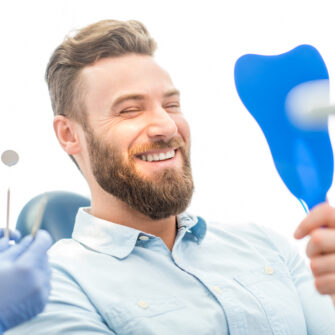Are dental X-rays safe?
We understand the health concerns the public has about being exposed to radiation. That’s why the American Association of Orthodontists (AAO) has created this helpful guide to dental X-rays. Learn more about the different types of X-rays, their uses, why they’re necessary, what you can expect from an X-ray imaging procedure, what sorts of radiation you’ll be exposed to, and what types of precautions our orthodontists take.
Why the Radiation Dose from Dental X-Rays is Safe
- Avoiding radiation is impossible; on average, a person receives a dose of 1.7 millirem (a unit measuring the effective dose of radiation, equivalent to 17 microsieverts) from natural background radiation daily.
- Dental X-rays expose patients to .1-.8 millirem of radiation, a very small amount (equivalent to 1-8 microsieverts)
- In comparison, dental X-rays usually expose patients to less than a daily dose of natural background radiation
- The benefits far outweigh the minimal risks; orthodontists need dental X-rays to see below the gum’s surface and create a plan to provide treatment effectively
Radiation from dental X-rays is so minimal that in 2024, an expert panel with the American Dental Association’s (ADA) Council on Scientific Affairs updated national recommendations to say protective gear like lead aprons and thyroid collars is no longer recommended. The amount of radiation is already so low that these extra layers simply aren’t necessary for your safety.
But Isn’t Radiation Harmful?
When someone mentions the word “radiation,” it can conjure images of atomic weapons, deadly invisible forces that can melt skin or give you cancerous growths, apocalyptic wastelands, and strange, abhorrent mutations.
While it’s true that ionizing radiation in very large doses can alter human cells, degrade DNA, increase the risks of cancer and other chronic diseases, and even lead to death, the amount of radiation patients are exposed to during a routine dental X-ray is negligible.
Additionally, over the years, X-ray technology has undergone significant improvements. These days, digital X-rays are used to reduce radiation exposure even further.
Digital Technology used in Dental X-rays:
- Require less energy due to computer image enhancement
- Use a narrower beam size
- Use monitoring equipment to measure and fine-tune radiation exposure
- Can be programmed to lower radiation dosages to the lowest possible required for a diagnosis
Finally, even though the amount of radiation you receive from your typical dental X-ray is minuscule, many dental professionals still elect to continue the use of lead aprons or thyroid shields as an additional precaution meant to give patients peace of mind.
How “Low” is a Low Dosage of Radiation?
If your orthodontist has asked you to get dental X-rays, it’s natural to be hesitant when either you or your child will be exposed to radiation.
Depending on which type of dental X-ray you receive, your average dental X-ray exposes you to between .1 and .8 Millirem of radiation, an extremely small dosage.
Did you know that you’re exposed to ionizing radiation from both the Earth and cosmic background radiation? Just existing, breathing in air, and eating food exposes the body to radiation. In essence, you or your child can’t completely avoid radiation exposure. In fact, the United States Nuclear Regulatory Commission estimates that Americans are exposed to 620 milirem (equivalent to 6,200 microsieverts) annually. That means that on average, you’re exposed to about 17 microsieverts a day just from background radiation. A dental X-ray emits less radiation than what you normally receive from living your daily life.
Minimizing Radiation Exposure

While radiation is not completely avoidable, the goal is to minimize unnecessary radiation exposure so that your body doesn’t need to absorb more than is considered healthy in a given time period. The United States Nuclear Regulatory Commission has established that a person who does not work with radioactive materials as part of their job should be exposed to no more than 100 millirem (equivalent to 1,000 microsieverts) of human-made radiation in addition to the average natural background radiation exposure per year.
100 millirem may not seem like a significant amount when you consider that annual background exposure is about six times that. However, 100 millirem is a large amount of radiation. To put everything in perspective, you’d need to get more than 100 dental X-rays in a single year to max out your safe man-made radiation exposure limit. No orthodontist would ever need anywhere close to 100 dental X-rays to create a treatment plan.
Why Are Dental X-Rays Necessary for Orthodontics?
One question that many of our orthodontists often receive is whether a dental X-ray is necessary for orthodontic treatment. The answer is a definite yes.
You cannot receive orthodontic treatment without a dental X-ray, and our orthodontists will not offer treatment without patients first getting dental X-rays.
Dental X-rays are essential for orthodontics because they let the orthodontist see what’s happening beneath the surface of your teeth and gums, which a simple visual exam or even a 3D scan can’t reveal. Specifically, X-rays help orthodontists:
Assess tooth position & development: X-rays show the exact alignment of teeth, root development, and whether any teeth are impacted (stuck under the gums) or coming in at unusual angles.
Evaluate jaw growth & structure: X-rays provide insight into the bones of the jaws and face, helping diagnose skeletal issues like overbites, underbites, or asymmetries that braces or other orthodontic treatments need to address.
Check for missing or extra teeth: They identify congenitally missing teeth or extra (supernumerary) teeth, which can affect the growth and development of the permanent teeth. Orthodontists may also use X-rays to assess the positions of wisdom teeth and predict how they will eventually impact treatment.
Monitor tooth and root health: X-rays can detect root resorption, cysts, or other problems that might affect long-term tooth health, movement, or stability during treatment.
Plan safe, effective treatment: Accurate diagnosis from X-rays helps orthodontists develop a treatment plan that minimizes complications and maximizes long-term results. This is the ultimate purpose of dental X-rays, and why our orthodontists insist on them.
Dental X-rays provide orthodontists with the full picture needed to move teeth safely, correct bite problems, and ensure your smile remains healthy and stable for years to come.
Trusting Your Oral Health to the Orthodontic Experts at AAO
It’s understandable to be concerned about exposing yourself or your family to radiation sources. After all, cartoons, movies, news reports, and popular media in general have hammered it into our minds that not much good can come from being exposed to radiation.
However, we live in a radioactive world. Everything we do, from breathing to drinking water, involves some level of radiation exposure. This isn’t a new phenomenon, either. Natural radioactive decay in the Earth’s elements or in food emits ionizing radiation, which we can’t avoid. And while it’s true that the harms of significant radiation exposure are well documented, the reality is that small doses of radiation are considered fine.
It is impossible to avoid radiation completely; the goal is to limit your exposure to only that which is necessary. In the case of evaluating orthodontic treatment, it’s completely necessary to obtain dental X-rays, allowing your orthodontist to view below the gumline and create an effective treatment plan that promotes a beautiful smile, healthy jaw, and better tooth positions.
Ultimately, with the latest advances in dental X-ray technology, we can limit patient exposure to such tiny amounts that it often doesn’t even equal the amount you receive from daily natural background radiation. Our orthodontists and their teams are trained to minimize your exposure to radiation while maximizing your improved health through personalized orthodontic treatment plans.
Ready to start your treatment? Find an AAO orthodontist today!



